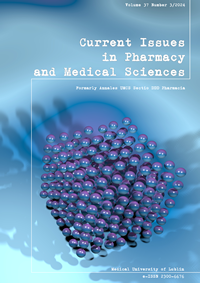Risk factors and skin colonization/recolonization – a matter in the development of sternal wound infection after cardiac surgery
DOI:
https://doi.org/10.2478/cipms-2024-0030Keywords:
surgical site infection, CABG, SWI, cardiothoracic surgery, microbiotaAbstract
Cardiac surgeries are classified as “clean procedures” as they do not involve access to any space populated by the patient's microbiota. Nevertheless, the development of sternal wound infection (SWI) can sometimes occur. The aim of the study was to analyze risk factors of SWI, efficacy of antiseptics procedures, skin microbiota colonization/recolonization, and their impact on infection development in patients undergoing cardiac surgery.
Of 500 patients who had undergone cardiac surgery through a median sternotomy, perioperative swabs of standardized surgical cut area were taken at three-time points: ‘1’-after admission to treatment rooms, ‘2’-before incision; ‘3’-before chest reconstruction. Material was cultured and grown bacterial colonies were counted.
Out of the total population, 23 patients developed SWI and 11 had suspicion of SWI while 466 were without SWI. Risk factors which had statistically significant impact of infection development were high body mass index (BMI) and use of cardiopulmonary bypass (CPB) during operation. The most common SWI-pathogens were coagulase-negative staphylococci (CoNS) and Gram-negative bacilli. From the perioperative period, CoNS and Staphylococcus aureus were isolated. When simultaneous positive cultures in 'swab-1 and -3' were observed (respectively, ≥87 and ≥17 bacterial colonies), the risk of complications was higher (patients with SWI – 69.57%; without SWI – 6.71%). Regarding point ‘3’, significant differences were noted in the general level of grown colonies. About 3 times more bacterial colonies were grown in the group with healing problems and SWI. SWI development is multifactorial. The rate of skin microbiota recolonization during surgery may suggests that being more colonized in the surgical incision area was more susceptible to local complications.
References
1. Zukowska A, Zukowski M. Surgical site infection in cardiac surgery.J Clin Med.2022;11(23):6991.
2. Kolasiński W. Zakażenia miejsca operowanego – przegląd aktualnej wiedzy, metody zapobiegania.Pol Przegl Chir.2019;91(4):41-7.
3. Ciuruś M. Przygotowanie pacjenta do zabiegu jako proces redukcji ryzyka zakażeń miejsca operowanego.Forum Zakażeń. 2014;5,3:171-6.
4. Malisiewicz A, Zymon A, Bazaliński D. Problems associated with local treatment of the sternum wound – a literature review.Surg Vascular Nurs.2023;17(1):6-17.
5. Siczyńska B, Miętkiewicz S, Dyk D. Analiza czynników ryzyka zakażenia miejsca operowanego oraz możliwości ich modyfikacji.Pielęg Chir Angiol.2014;2:56-61.
6. Vos RJ, Van Putte BP, Kloppenburg GTL. Prevention of deep sternal wound infection in cardiac surgery: a literature review.J Hosp Infect.2018;100(4):411-20.
7. Munguira JB. Pneumonia in patients undergoing major heart surgery: Why intensify treatment and preventative measures? JPulmonar Respirat Med.2012;2:e108.
8. Song Y, Chu W, Sun J, Liu X, Zhu H, Yu H, et al. Review on risk factors, classification, and treatment of sternal wound infection.J Cardiothorac Surg.2023;18:184.
9. Yang J, Zhang B, Qu C, Liu L, Song Y. Analysis of risk factors for sternal wound infection after off-pump coronary artery bypass grafting.Infect Drug Resist.2022;15:5249-56.
10. Bartoszewicz M, Rygiel A. Biofilm jako podstawowy mechanizm zakażenia miejsca operowanego - metody prewencji w leczeniu miejscowym.Chir Pol.2006;8,3:171-8.
11. Piątkowska E, Mazurkiewicz J, Bartosiewicz M. Profilaktyka zakażeń miejsca operowanego - przegląd aktualnych wytycznych.Forum Zakażeń. 2018;9(2):91–95.
12. Gondek S. Antyseptyczna kąpiel przedoperacyjna – czy zawsze skuteczna w redukcji ZMO?Zakażenia. 2014;4:48-52.
13. Grzybowska W, Bocian E, Laudy A, Tyski S. Ocena bakteriobójczej oraz bójczej aktywności wobec grzybów drożdżopodobnych preparatu zawierającego chlorheksydynę i chlorek didecylodimetyloamoniowy (1:1) z zastosowaniem szczepów standardowych oraz wielolekoopornych klinicznych szczepów bakterii, według Norm Europejskich.Med Dośw Mikrobiol.2019;71:137-47 .
14. Kühme T, Isaksson B, Dahlin LG: Wound contamination in cardiac surgery. A systematic quantitative and qualitative study of the bacterial growth in sternal wounds in cardiac surgery patients.APMIS. 2007;115(9):1001-7.
15. Furui M, Kong PK, Moorthy PSK, Soon CK, Akhtar KMA, Shamsuddin AM, et al. Risk factors for sternal wound infection after coronary artery bypass grafting in patients with and without diabetes.Int Heart J.2022;63(3):426-32.
16. Falk-Brynhildsen K, Friberg O, Söderquist B, Nilsson UG. Bacterial colonization of the skin following aseptic preoperative preparation and impact of the use of plastic adhesive drapes.Biol Res Nurs.2013;15(2):242-8.
17. Jolivet S, Lucet JC. Surgical field and skin preparation.Orthop Traumatol Surg Res.2019;105(1S):S1-S6.
18. Falk-Brynhildsen K, Söderquist B, Friberg O, Nilsson UG. Bacterial recolonization of the skin and wound contamination during cardiac surgery: a randomized controlled trial of the use of plastic adhesive drape compared with bare skin.J Hosp Infect.2013;84,2:151-8.
19. Rouquette L, Traore O, Descamps S, Boisgard S, Villatte G, Erivan R. Bacterial skin recolonization in the operating room: comparison between various antisepsis protocols.J Hosp Infect.2020;106(1):57-64.
20. Kotnis-Gąska A, Mazur P, Olechowska-Jarząb A, Stanisz A, Bulanda M, Undas A. Sternal wound infections following cardiac surgery and their management: a single-centre study from the years 2016-2017.Pol J Thorac Cardiovasc Surg.2018;15(2):79-85.
21. Sharif M, Wong CHM, Harky A. Sternal wound infections, risk factors and management - how far are we? A literature review.Heart Lung Circ.2019;28(6):835-43.
22. Buja A, Zampieron A, Cavalet S, Chiffi D, Sandonà P, Vinelli A, et al. An update review on risk factors and scales for prediction of deep sternal wound infections.Int Wound J.2012;9,4:372-86.
23. Szkiler E. Zakażenie ran i owrzodzeń – postępowanie w praktyce pielęgniarskiej.Pilęg Anestezjol Intens Opiece.2019;5(2):47-52.
24. Kowalska-Krochmal B. Diagnostyka mikrobiologiczna – skuteczne i proste narzędzie w rozpoznawaniu i leczeniu miejscowych i ogólnych zakażeń w chirurgii.Sepsis. 2010;3,1:15-7.
Downloads
Published
Issue
Section
License
Copyright (c) 2024 Authors

This work is licensed under a Creative Commons Attribution-NonCommercial-NoDerivatives 3.0 Unported License.


